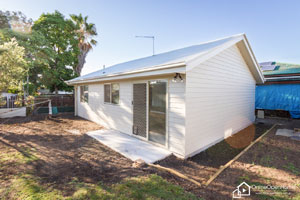Blog
Renting out the Granny Flat May Mean Losing Tax Concessions … posted on the 30th April 2014

Ipswich Granny Flats : We are often asked ‘What happens if we build a Granny Flat in our backyard now, then we go to sell our home at a later date ? What are the tax implications for us?’
I’m not an accountant so I cannot answer the question, all I can do is refer that person to their Accountant or Tax Adviser.
You might find the recent article below provides some useful information …
Dubbo Weekender
15.4.14
Peter Scolari, Scolari Comerford
THE range of “granny flat” scenarios in Australia is quite extraordinary – from the “garden variety” (excuse the pun) to homeowners actually building granny flats in their backyards and leasing them out to people, almost like a business.
While it may not be possible to deal with, or even imagine, all the possible scenarios, this article explains the capital gains tax (CGT) consequences of basic granny flat scenarios. Specifically, it looks at the Government’s tax concession which allows homeowners to sell their home tax-free – this concession is known as the “CGT main residence exemption”.
Basic scenarios

Let’s agree on a basic scenario where a granny flat is built in the backyard or a separate garage is converted into a unit of accommodation for occupation by, for example, your adult children, your elderly parents or your in-laws.
In this situation, assuming no commercial type rent is charged, there will be no loss of the CGT main residence exemption on any subsequent sale of the whole property. Essentially, this is because under tax law the CGT exemption for the disposal of a main residence extends not only to the dwelling, but also to “adjacent land” and structures built on it provided they are “used primarily for private or domestic purposes in association with the dwelling”. This rule would cover the basic scenario described above even if the granny flat occupants were paying outgoings such as electricity, rates and repairs etc.
However, if the granny flat occupants were paying commercial rent, then a partial tax exemption would apply on the basis that the main residence (which includes any adjacent land) was being used for income-producing purposes. That is, there would be a CGT liability for that portion of the property that had been used for renting out the granny flat.

The CGT liability is usually calculated on an area and time basis. If, for example, the income use amounts to only 10 per cent of the area of the property and only occurred for two years until the sale of the property 10 years later, then any assessable capital gain or loss, say $100,000, would be apportioned by reference to this 10 per cent income use for two out of the 10 years – i.e. 1/10th x 2/10ths, being 2/100ths – resulting in an assessable capital gain of $2000 which would be also entitled to the 50 per cent CGT discount as the property had been owned for more than 12 months.
The above calculation is for illustrative purposes only. Real-life will always throw up more complexities. For example, a difficulty not dealt with in the above calculation is that tax law will require you to know the market value of the property at the time the granny flat was first used to produce income.
Even in this case, where commercial rent is charged for occupation of a granny flat, it may be possible to argue, depending on the circumstances, that no partial exemption applies – that is, the full exemption applies. This is because the main residence exemption extends to adjacent land “to the extent that the land was used primarily for private or domestic purposes in association with the dwelling”. In this regard, the phrases “to the extent” and “primarily” may be wide enough to encompass the case where a granny flat is rented at commercial rates for a limited period (at least in relation to the total ownership of the property) – especially if rented to family members. However, it would be prudent to contact us for advice, and possibly obtain a private ruling from the ATO, to verify this view.
Other points to note about these basic scenarios:
In the situation where parent(s) move out of the main residence and let their children or a child and their spouse occupy the main residence as their home, then presumably the CGT main residence exemption will be available on any subsequent sale as it appears that the basic requirements for the exemption will still be met in this situation – provided the parent(s) remain the legal owners of the property. Alternatively, the “absence concession” in the tax law would be available to validly preserve the exemption.
If the land occupied by the separate granny flat is subdivided and sold (e.g. to the occupiers), then no CGT exemption would apply to any capital gain or loss made on the sale.
In the related situation where a room in a dwelling is rented at commercial rates (usually to a non–family member), the situation is clear that a partial exemption for income use will apply.
More unusual scenarios
The range of granny flat scenarios is unlimited due to the variety of family lifestyles and legal uses of land that can occur in this country. This means that there can be as many CGT (and other tax) implications of the arrangements (including land tax) as there are granny flat arrangements.
Take, for example, the not-so-uncommon situation where a couple owns a holiday home on the coast or in the country, and local council laws permit the building of another structure for accommodation on the land (say for a parent-in-law or an adult child working in the region). Assume the couple owns a dwelling elsewhere which qualifies as the main residence for CGT exemption purposes. What would be the CGT and tax implications in this situation?
In this case it would seem that the building of the structure would amount to a capital improvement to the land, the cost of which would be added to the cost base of the land for the calculation of any subsequent CGT liability on the disposal of the land – despite the fact that the structure qualifies as a unit of accommodation which has become the main residence of the occupier. In this case, a key consideration is the fact that the CGT main residence exemption is only available if the occupier has an “ownership interest” in the dwelling, and which is clearly not the case here.
No small matter
In summary, there is a growing phenomenon where people build granny flats in their backyards for the purpose of letting them out on a commercial basis. Clearly, in these cases, the rent would be assessable income, relevant deductions would be available and a partial CGT exemption would apply on any subsequent disposal of the dwelling on the basis of income use. In certain cases, the Commissioner may regard such “enterprises” as a business activity – and require profits and losses to be accounted for on a business basis.
This article has hardly scratched the surface of the granny flat arrangements and the resulting tax implications. The issue of granny flats and CGT is no small matter for a range of reasons, including significant population rises in big cities, increasing immigration levels (and any cultural norms of extended family living), the ageing population, transport issues, rising house prices, and problems with the availability of urban land for development. And don’t forget, of course, the possibility of the revenue available from such scenarios in these budget-strapped days. However, bear in mind that the costs of collecting such revenue may well outweigh any revenue collected.
The above article has been supplied for information purposes only. If you have question in relation to the tax implication of building a granny flat, whether in your own backyard or your investment property – ask the experts!
Talk to your Accountant or Tax Adviser …
Written by Sonia Woolley
